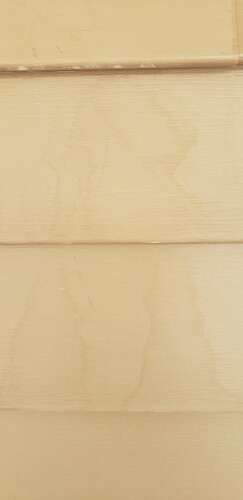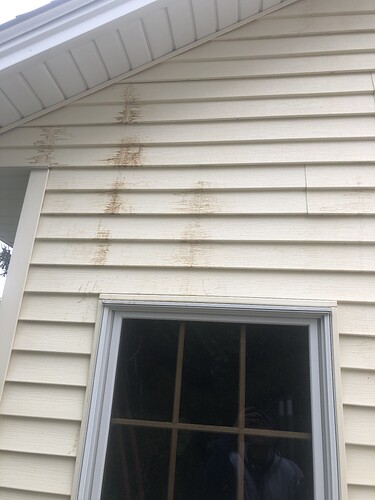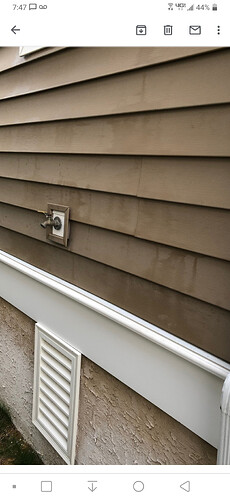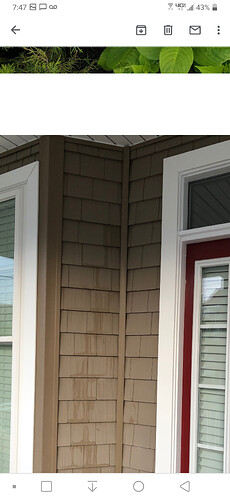I have tried searching to figure out what is causing these streaks left behind after water dries and cant find anything. It has been happening at many of the houses I’ve done but usually disappears after a couple rains. Haven’t had a customer complain yet but bothers me. At first I thought I was using too much soap so I tried less elemonator but didnt change. It seems no matter how much I rinse, when the siding starts to dry it leaves these spots. It seems especially worse on sunny sides where the water dries quickly. Advice please?`
Need to rinse more. What is your GPM?
I had this problem with my 4gpm machine until I upgraded to a 5.5.
Sometimes the mix can get behind siding or behind gutters and continue to seep out even after you have rinsed. Especially if you apply too much in one area with a good amount of pressure. I would suggest keeping distance while applying or fanning out your spray so there is less pressure and concentration of mix and an even coat applied. This might help eliminate it getting behind siding and falling out after rinsing… If that is the issue here.
This link might help
A few things to try - elemonator suggests 1 ounce per gallon of mix. I’ve found that to be way too much. Try using 1 ounce for every 3 gallons of mix.
Sometimes pre-wetting has helped, although I have no idea why or maybe just a coincidence.
Apply the mix from a further distance than what you currently are. This will reduce the amount of mix getting behind the siding.
Rinse, rinse, and rinse some more.
After you have finished rinsing, give it a few minutes to let all the weep holes on the siding drain out. Then do a final, light rinse at a distance to avoid pushing any more water behind the siding, but heavy enough to rinse down any remaining mix that may have leaked down.
@DJPWS nailed it. If you truly are rinsing good enough it’s really the only thing it could be. I’ve had it happen too. Don’t shoot water straight up and onto the siding. Stay back, mist from the side at an angle, and let it rain down onto the siding in the direction of the overlap. If you’re still having issues after all that go back around one more time after the water has had a chance to run out from behind the siding and do a fine mist over everything. You need to be careful about blasting water behind the siding. I bet you’re using your second story rinse tip a lot in the areas it’s happening. Use the fan tip to mist water from a distance and you should be fine. You want the water falling down on the siding not forcing water up underneath it.
Try and remember what color siding it’s happening to. I’ve this happen on blues, greens, some greys and one tan house. They all seem to have issues with early oxidation some where on the house. Pay attention to those houses after a rain storms. They will look the same. It takes days to dry.
Once it rains it will go away.
Thanks for the feedback. I will see if I can soap/ rinse further away and longer. I already try to use the soap tip for rinsing as much as possible and only use the 2nd story tip for high spots and I stand way back. I am using a 5.5gpm machine. I will have to experiment with less soap and lighter rinsing.
Those things can be annoying but a light rinse usually takes care of it. This happened yesterday and I have never seen something quite like this; happened in a couple of spots. Country home on a well where the water flow was the worst I have ever seen and atrocious winds. Was this rust behind their siding lol?
I believe i know the root cause of those nasty brown streaks. I found out that 1 or 2 of 10 houses will do it fairly bad. The contractor who built the home hadn’t put the Tyvec on properly or rushed the job. Causing water to build up behind the Tyvec instead of in-front. Which in turns gets the particle board wet behind the Tyvec. The Root of the problem is wet particle board. If you have ever seen wet particle board drain over anything its exactly what you see on the siding. Best way to get rid of it is CLR. Only after the house has drained from water for couple days though or you will be fighting a losing battle. These houses in my opinion **** cause if you want a happy customer your obligated to ho back and fix it for free.
I’ve never seen particle board used behind siding. Maybe it’s only used in certain areas? Most use OSB around here and, back in the 50’s through maybe the 70’s used that 1/2" thick pressed cardboard that had a tar paper type look to the front. I think it’s called fiberboard. I don’t believe it’s used much anymore.
Well I’ve done a few more houses since I posted this and have not had any more issues. A combination of less soap and standing even further back seemed to work. Thanks everyone
Less soap, stand further back and pay close attention to the direction of the siding overlapping.
Here ya go. Customer just sent this to me. I’ve been doing his house for 6 years. I only put in 3 inches of SH in a 5 gallon bucket with a dash of elemonator. Dark colored siding is funny. It hasn’t rained since I did his house. I’ll go back in a few days and soap it again. Hopefully it goes away this time. He’s worried it’s my soaps that stained his siding.
Correction on the particle board. It is OSB that i ment.
I went back yesterday and checked the house with the brown siding in the pics I posted above and it’s still very faintly wet 5 days later. It supposed to rain this Saturday and i can’t get out there till next week to resoap and rinse. I hope that the rain rinses it down before I get there but I will update this thread on the outcome.
I hate doing dark houses lol. There always seems to be streaking no matter how well and how light you rinse.
I have noticed that houses with light oxidation can leave “streaks” on the spots that dry last. It seems to happen worse on the sides where the sun dries really fast and concentrates some of the chalkiness into streaks. hope that makes sense, I try and follow up with a couple really light misting rinses to slow down the drying and that seems to help a little but I also warn the customer and set expectations.






